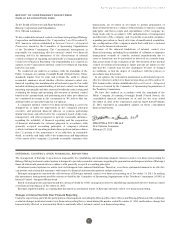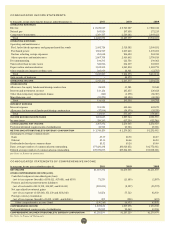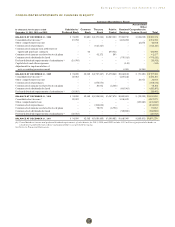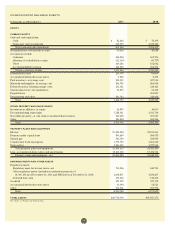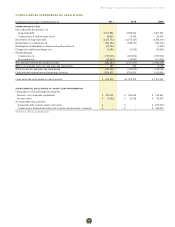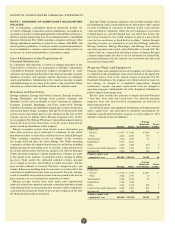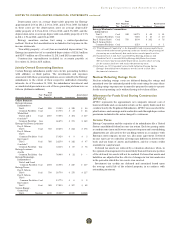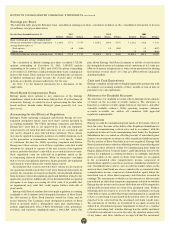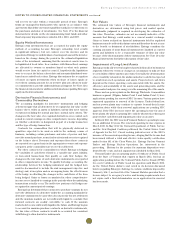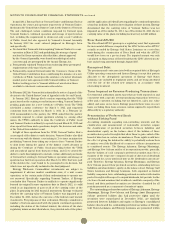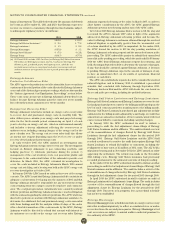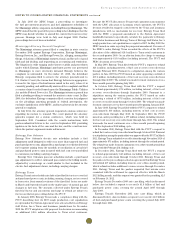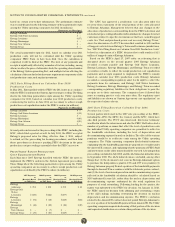Entergy 2011 Annual Report Download - page 67
Download and view the complete annual report
Please find page 67 of the 2011 Entergy annual report below. You can navigate through the pages in the report by either clicking on the pages listed below, or by using the keyword search tool below to find specific information within the annual report.
Entergy Corporation and Subsidiaries 2011
NOTES TO CONSOLIDATED FINANCIAL STATEMENTS continued
will recover its value within a reasonable period of time. Entergy’s
trusts are managed by third parties who operate in accordance with
agreements that define investment guidelines and place restrictions on
the purchases and sales of investments. See Note 17 to the financial
statements for details on the decommissioning trust funds and other
than temporary impairments recorded in 2011, 2010, and 2009.
Equity Method Investments
Entergy owns investments that are accounted for under the equity
method of accounting because Entergy’s ownership level results
in significant influence, but not control, over the investee and its
operations. Entergy records its share of earnings or losses of the investee
based on the change during the period in the estimated liquidation
value of the investment, assuming that the investee’s assets were to
be liquidated at book value. In accordance with this method, earnings
are allocated to owners or members based on what each partner
would receive from its capital account if, hypothetically, liquidation
were to occur at the balance sheet date and amounts distributed were
based on recorded book values. Entergy discontinues the recognition
of losses on equity investments when its share of losses equals or
exceeds its carrying amount for an investee plus any advances made
or commitments to provide additional financial support. See Note 14 to
the financial statements for additional information regarding Entergy’s
equity method investments.
Derivative Financial Instruments and
Commodity Derivatives
The accounting standards for derivative instruments and hedging
activities require that all derivatives be recognized at fair value on the
balance sheet, either as assets or liabilities, unless they meet various
exceptions including the normal purchase, normal sales criteria. The
changes in the fair value of recognized derivatives are recorded each
period in current earnings or other comprehensive income, depending
on whether a derivative is designated as part of a hedge transaction
and the type of hedge transaction.
Contracts for commodities that will be physically delivered in
quantities expected to be used or sold in the ordinary course of
business, including certain purchases and sales of power and fuel,
meet the normal purchase, normal sales criteria and are not recognized
on the balance sheet. Revenues and expenses from these contracts
are reported on a gross basis in the appropriate revenue and expense
categories as the commodities are received or delivered.
For other contracts for commodities in which Entergy is hedging
the variability of cash flows related to a variable-rate asset, liability,
or forecasted transactions that qualify as cash flow hedges, the
changes in the fair value of such derivative instruments are reported
in other comprehensive income. To qualify for hedge accounting, the
relationship between the hedging instrument and the hedged item
must be documented to include the risk management objective and
strategy and, at inception and on an ongoing basis, the effectiveness
of the hedge in offsetting the changes in the cash flows of the item
being hedged. Gains or losses accumulated in other comprehensive
income are reclassified to earnings in the periods when the underlying
transactions actually occur. The ineffective portions of all hedges are
recognized in current-period earnings.
Entergy has determined that contracts to purchase uranium do not
meet the definition of a derivative under the accounting standards for
derivative instruments because they do not provide for net settlement
and the uranium markets are not sufficiently liquid to conclude that
forward contracts are readily convertible to cash. If the uranium
markets do become sufficiently liquid in the future and Entergy begins
to account for uranium purchase contracts as derivative instruments,
the fair value of these contracts would be accounted for consistent
with Entergy’s other derivative instruments.
Fair Values
The estimated fair values of Entergy’s financial instruments and
derivatives are determined using bid prices and market quotes.
Considerable judgment is required in developing the estimates of
fair value. Therefore, estimates are not necessarily indicative of the
amounts that Entergy could realize in a current market exchange.
Gains or losses realized on financial instruments held by regulated
businesses may be reflected in future rates and therefore do not accrue
to the benefit or detriment of stockholders. Entergy considers the
carrying amounts of most financial instruments classified as current
assets and liabilities to be a reasonable estimate of their fair value
because of the short maturity of these instruments. See Note 16 to the
financial statements for further discussion of fair value.
Impairment of Long-Lived Assets
Entergy periodically reviews long-lived assets held in all of its business
segments whenever events or changes in circumstances indicate that
recoverability of these assets is uncertain. Generally, the determination
of recoverability is based on the undiscounted net cash flows expected
to result from such operations and assets. Projected net cash flows
depend on the future operating costs associated with the assets, the
efficiency and availability of the assets and generating units, and the
future market and price for energy over the remaining life of the assets.
Three nuclear power plants in the Entergy Wholesale Commodities
business segment (Pilgrim, Indian Point 2 and Indian Point 3) have
applications pending for renewed NRC licenses. Various parties have
expressed opposition to renewal of the licenses. Under federal law,
nuclear power plants may continue to operate beyond their license
expiration dates while their renewal applications are pending NRC
approval. If the NRC does not renew the operating license for any of
these plants, the plant’s operating life could be shortened, reducing its
projected net cash flows and impairing its value as an asset.
In March 2011 the NRC renewed Vermont Yankee’s operating license
for an additional 20 years. The renewed operating license expires in
March 2032. In May 2011 the Vermont Department of Public Service
and the New England Coalition petitioned the United States Court
of Appeals for the D.C. Circuit seeking judicial review of the NRC’s
issuance of the renewed operating license, alleging that the license had
been issued without a valid and effective water quality certification
under Section 401 of the Clean Water Act. Entergy Nuclear Vermont
Yankee and Entergy Nuclear Operations, Inc. intervened in the
proceeding. Motions by the parties for summary disposition were
denied by the court, and oral argument is scheduled for May 2012.
Vermont Yankee also is operating under a Certificate of Public Good
from the State of Vermont that expires in March 2012, but has an
application pending before the Vermont Public Service Board (VPSB)
for a new Certificate of Public Good for operation until March 2032.
As the United States district court noted in its decision discussed
below (regarding Entergy’s challenge to certain conditions imposed by
Vermont), title 3, section 814 of the Vermont Statutes provides that a
license subject to an agency’s notice and hearing requirements does
not expire until a final determination on an application for renewal
has been made.
65


